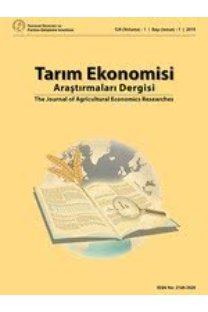Dünyada Buğdayın Simetrik Piyasa Entegrasyonu
Entegrasyon, Piyasa, Buğday, Dünya
Symmetric Market Integration of Wheat in the World
Integration, Market, Wheat, World,
___
- Ahuja, N.L. (2006). Community derivatives market in India: development, regulation and futures prospects. International Research Journal of Finance and Economics, 2:153-62.
- Beag, F.A. and Singla, N. (2014). Cointegration, causality and impulse response analysis in major Apple markets of India. Agricultural Economics Research Review, 27(2):289-298.
- Berg, A. (2011). The Rise of Commodity Speculation: from Villainous to Venerable. In: Prakash, A.(Ed.), Safeguarding Food Security in Volatile Global Markets. FAO. Pp. 255-280
- Christiaensen, L. and Demery, L. (2006). Revisiting the role of agriculture in poverty reduction in sub-Saharan Africa. World Bank Report Paper.
- Easley, D., Engle, R., OHara, M. and Wu, L. (2008). Time-varying arrival rates of informed and uninformed trades. Journal of Financial Econometrics, 6(2):171–207.
- Ghafoor, A., Mustafa, K., Mushtaq, K. and Abedulla (2009). Cointegration and causality: An application to major mango markets in Pakistan. Lahore Journal of Economics, 14(1):85- 113.
- Goodwin, B. K., Holt, M.T. and Prestemon, J.P. (2008). North American oriented strand board markets, arbitrage activity, and market price dynamics: A smooth transition approach. MPRA Paper, 9684. University Library of Munich, Germany.
- Grandmont, J. (1977). Temporary general equilibrium theory. Econometrica, 45:535-72.
- Granger, C.W.J. (1969). Investigating causal relations by econometric models and cross-spectral methods. Econometrica: Journal of the Econometric Society, 37(1):424-438.
- Johansen, S. (1988). Statistical analysis of co-integration vectors. Journal of Economic Dynamics and Control, 12(2-3): 231-254.
- Kohl, S.R.L. and Uhl, J.N. (1998). Marketing of Agricultural Product, Fifth Edition, Macmillan, New York.
- Malinvaud, E. (1966). Statistical Methods of Econometrics. Rand McNally, Chicago. Pp. 195-197.
- Mushtaq, K., Abdul, G. and Maula, D. (2008). Apple market integration: implications for sustainable agricultural development. The Lahore Journal of Economics, 13: 129-138.
- Poulton, C., Kydd, J., Wiggins, S. and Doward, A. (2006). State interventions for food price stabilization in Africa: Can it work?. Food Policy, 31: 342-356
- Prakash, A. and Stigler, M. (2011). The Economics of Information and Behaviour in Explaining Excess Volatility. In: Prakash, A.(Ed.), Safeguarding Food Security in Volatile Global Markets. FAO. Pp. 281
- Praveen, K.V. and Inbasekar, K. (2015). Integration of agricultural commodity markets in India. International Journal of Social Science, 4(1): 51-56
- Rahman, M.M. and Shahbaz, M.(2013).Do imports and foreign capital inflows lead economic growth? cointegration and causality analysis in Pakistan. SouthAsia Economic Journal, 14(1): 59-81.
- Rapsomanikis, G.(2011). Price Transmission and Volatility Spillovers in Food Markets. In: Prakash, A.(Ed.), Safeguarding Food Security in Volatile Global Markets. FAO. Pp. 150-151
- Sadiq, M S., Singh, I.P., Aminu, S. and Grema, I. J. (2017). Volatility and price discovery of palm oil in international markets under different trade regime. Journal of Agricultural Economics, Environment and Social Sciences, 3(1): 33–50.
- Sadiq, M S., Singh, I.P., Suleiman, Aminu, Umar, S.M., Grema, I.J., Usman, B.I., Isah, M.A. and Lawal, A. T. (2016a). Extent, pattern and degree of integration among some selected cocoa markets in West Africa: An innovative information delivery system. Journal of Progressive Agriculture, 7(2): 22-39.
- Sadiq, M.S., Karunakaran, N. and Singh, I.P. (2018). Integration of banana markets in India. ICTACT Journal on Management Studies, 4(2): 764-781
- Sadiq, M.S., Singh, I.P. and Ahmad, M.M. (2020). Market integration of sesame seeds in South Asia. Alanya Academic Review, 4(1): 143-155.
- Sadiq, M.S., Singh, I.P., Suleiman Aminu, Umar, S.M., Grema, I.J., Usman, B.I., Isah, M.A. and Lawal, A.T. (2016b). Price transmission, volatility and discovery of gram in some selected markets in Rajasthan State, India. International Journal of Environment, Agriculture and Biotechnology, 1(1): 74-89.
- Shahbandeh, M. (2021). Wheat-production volume worldwide 2011/2012-2020/21. Retrieved on 10/11/2021 from https://www.statista.com/statistics/267268/production-of-wheat- worldwide-since-1990/
- Thomas, S. (2003). Agricultural Commodity Market in India. Indira Gandhi Institute for Development Research (IGIDR), Mumbai, India
- Wani, M.H., Paul, R.K., Bazaz, N.H. and Manzoor, M. (2015). Market integration and price forecasting of apple in India. Indian Journal of Agricultural Economics, 70(2): 171-181.
- Yayın Aralığı: Yılda 2 Sayı
- Başlangıç: 2015
- Yayıncı: Tarımsal Ekonomi ve Politika Geliştirme Enstitüsü Müdürlüğü
Dünyada Buğdayın Simetrik Piyasa Entegrasyonu
Mohammed Sanusi SADIQ, Invinder Paul SINGH, Muhammad Makarfi AHMAD
Akhisar’da Sofralık Zeytin İhracatındaki Değişimlerin İncelenmesi
Türkiye’de Nohut Üretim Alanını Etkileyen Faktörlerin ARDL Modeli ile Analizi
İlyas AKDOĞAN, Bülent GÜLÇUBUK
Türkiye’de Şeker: Üretim, Tüketim, Ticaret ve Politikaların Kısa Bir Tartışması
Samsun İli Atakum İlçesindeki Hanehalklarının Kestane Satın Alma ve Tüketim Davranışları
Gamze BAL, Uğur BAŞER, Mehmet BOZOĞLU
Ferit ÇOBANOĞLU, Halil İbrahim YILMAZ, Sıdıka BOZKIRAN YILMAZ
Tarımsal Destekler ve Tarımsal Üretim İlişkisi: Türkiye Ekonomisi Üzerine Ampirik Bulgular
